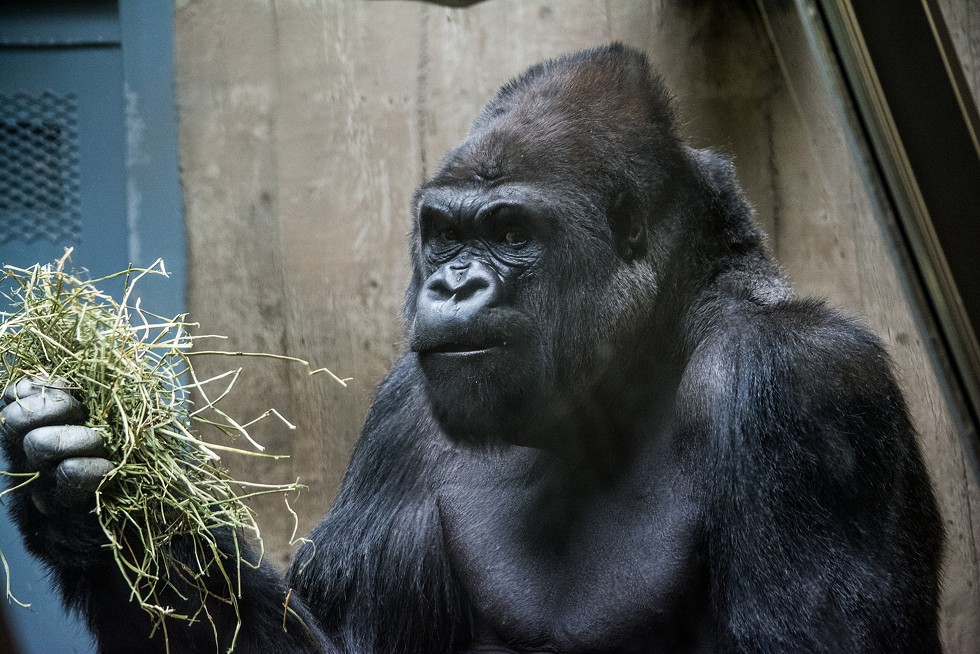Just before 8 o'clock on a snowy Wednesday morning, deep in a maze of doors and steel fencing in the basement of the Cleveland Metroparks Zoo, a 30-year-old gorilla named Mokolo is getting a heart exam. He's voluntarily shambled up to a stainless-steel fence, squatted on his stout legs, and pressed his belly to the mesh. Now he looks at the ceiling with thinly veiled exasperation, like a kid who wants to play outside but knows he has to stand still long enough to get slathered with sunscreen first. His expression is so recognizably human that it's disconcerting.
An animal keeper, Brian Price, crouches on the other side of the mesh. "There you go, Moki," he murmurs, passing a green bean into Mokolo's mouth as a treat. The 400-pound animal gently accepts it with his lips.
Through a small opening in the fence, Price rubs ultrasound gel on Mokolo's thrust-out belly. Mokolo bats at Price's hand. He wipes off some of the goo and examines it with a suspicious expression, frowning as he rubs it between thumb and forefinger. Then, as though satisfied it's the same substance Price used last week, he raises his arm above his head and looks back at the ceiling. His fingers, with black nails and creased knuckles, curl around the steel fencing.
"Hold," says Price softly, rolling an ultrasound probe over Mokolo's ribs. Mokolo holds still.
A few feet away, a pulsating gray-and-white image of Mokolo's heart appears on a portable ultrasound machine. Mike Selig, a staff veterinarian, watches the right ventricle flutter open to let in blood, and the left ventricle pump it out. Rhythmic and regular: Good. Selig records Mokolo's heart rate, then pushes a button to capture a photo. Later, he'll measure the fluid that's collected around Mokolo's heart cavity to make sure it hasn't increased, and add the information to a national database.
Like many captive male gorillas, Mokolo suffers from heart disease —specifically, fibrosing cardiomyopathy, a condition that turns red, healthy heart muscle into bands of white scar tissue too rigid to pump blood. Although heart disease is nearly absent in wild populations, it's the leading killer of captive male gorillas around the world. Roughly 70 percent of adult male gorillas in North America have heart disease, and many die prematurely as a result. Other great apes, such as orangutans and chimpanzees, suffer at similar rates.
For more than a decade, zookeepers, veterinarians, epidemiologists and others have struggled to figure out why heart disease is so prevalent among captive apes, and how to prevent the animals from developing it. Now they may be closing in on an answer — one that lies not in the 20-ounce time bombs housed in gorillas' chests, but in the microscopic bacteria that flourish in their guts.
***
During the Miocene epoch, 23 million to 5.3 million years ago, at least 100 species of apes lived in the tropical forests of the Old World. Some were as small and light-footed as house cats; others weighed as much as modern gorillas. As the climate got cooler and drier, Miocene forests gave way to grasslands, and most ape species went extinct. Gorillas, bonobos, orangutans, and chimpanzees were among the survivors.
But the animals we now call the great apes weren't alone. Another type of hominid held on too, and its brain eventually grew complex enough to use tools, cultivate fire, and invent the bulldozers and chain saws that are today tearing down great apes' last ecological strongholds. Largely because of logging, agriculture, and poaching by humans, the International Union for Conservation of Nature considers all six species of great apes endangered, with four of the six — the eastern gorilla, western gorilla, Bornean orangutan, and Sumatran orangutan — critically endangered.
While humans have pushed wild apes to the edge of a second mass extinction, we have an abiding zeal for keeping our closest evolutionary kin in captivity. Some of the earliest captive apes were held in menageries owned by European royals in the 17th and 18th centuries, an era when intellectuals debated whether apes were exotic beasts or some distant, savage race of humans. Without a clear answer, the creatures were treated as both — shackled with iron chains but given linens for their bed and meals of bread, strawberries, and fine Spanish wine.
By the early 20th century, scientists had managed to classify great apes into distinct species, but still had little idea how to care for them. The first gorilla to cross the Atlantic ocean into North America, a female western lowland gorilla named Madame Ningo, arrived at New York's Bronx Zoo from the French Congo in 1911. Perhaps because she so closely resembled a human — or because her oversized canines suggested the mandible of a vicious carnivore — zookeepers tried feeding her cooked meat and other hot dinners from the nearby Rocking Stone restaurant. They were perplexed when she refused to eat.
Within two weeks, Madame Ningo died. The zoo director, William Temple Hornaday, wrote bitterly that the animal "deserved to be [dead], for its obstinacy." Perhaps he didn't realize that gorillas are herbivores — their sharp canines are for stripping bark off fibrous African plants or baring at opponents in mating displays, not tearing through steaks. Madame Ningo's successor, Dinah, suffered a similar fate, dying after 11 months from a lack of appetite despite no apparent pathological symptoms.
Yet zoos continued their quest to bring gorillas to North American audiences. "Undoubtedly, the highest desire of every zoological garden and park ... is to own and exhibit a real, live gorilla of a size sufficiently large to compel both admiration and awe," Hornaday wrote in 1915. As the 20th century progressed, care of gorillas improved — especially after the passage of the 1973 Endangered Species Act, which banned the import of endangered wild apes and gave zoos even greater impetus to maintain self-sustaining captive populations.
By the early 1990s, the roughly 230 zoos accredited by the Association of Zoos and Aquariums had begun to shift their purpose from purveyors of "admiration and awe" to serious partners in conservation and education. They adopted mandates to contribute money and manpower to field conservation, and to educate visitors on the threats faced by endangered species. Zoos created "species survival plans" to ensure that captive populations of gorillas and other endangered species were robust enough to act as insurance in case wild populations edged too close to extinction. But early misconceptions about gorillas proved hard to shake. Well into the '90s, some zoos still fed the animals milk, yogurt, boiled eggs, meat, bread, popcorn, and apples baked with cinnamon.
The invention of processed, calorically dense "biscuits" packed with vitamins and nutrients and supplemented with a few fruits and vegetables eventually helped standardize gorilla diets. Animals on the biscuit diet began living longer, seemingly healthier lives, sometimes surviving into their 50s. Infant mortality rates dropped. One female gorilla, Jo Ray K, gave birth to five fuzz-headed infants, including a rambunctious baby boy born on July 10, 1987. Zookeepers named him Mokolo.
***
When mokolo arrived at the Cleveland Metroparks Zoo in 1994, he helped establish a bachelor group with three other young males. Wild gorillas often live in bachelor groups when they're young, and Mokolo settled easily into his new social role. From the start, says the zoo's executive director and animal behaviorist Chris Kuhar, Mokolo stood out for his big personality. "He was the punky kid who caused trouble," Kuhar recalls. "But he was also the peacemaker. He was the one who wanted to play, or who wanted to fight, or cuddle."
Like the 350 or so other gorillas living in AZA zoos, Mokolo appeared relatively content and healthy. Nearly a century after Madame Ningo arrived in the New World, it seemed zoos had finally figured out great-ape husbandry.
Then the silverbacks started dying.
In 2006 alone, three beloved male gorillas from 21 to 34 years of age died in quick succession. The culprit turned out to be heart disease. Largely unbeknownst to zookeepers and veterinarians, the disease had been creeping into the hearts of great apes much as it had crept into human hearts in the 20th century. But unlike humans, gorillas with heart problems didn't show evidence of coronary-artery blockage or high cholesterol. And unlike human hearts, gorilla hearts were almost unknown territory to scientists.
"We didn't even have a definition of heart disease in gorillas," says Pam Dennis, a veterinary epidemiologist with Cleveland Metroparks Zoo and assistant professor at the Ohio State University College of Veterinary Medicine. Once an animal was dead, it was easy enough to identify heart failure through a necropsy, but since there were no parameters for healthy gorilla hearts, diagnosis and treatment in living animals was tricky. And because heart disease increases the risk of death during anesthesia, veterinarians were reluctant to anesthetize gorillas to perform ultrasounds, install pacemakers, or draw blood to study the disease. Even after the Great Ape Heart Project was created in 2010 to synthesize heart-health information from apes around the country, data arrived in a trickle rather than a flood.
"No vet would anesthetize an adult male gorilla unless they absolutely needed to," Dennis recalls. "Routine health exams just sort of stopped."
The first breakthrough came as veterinarians and zookeepers realized they could use apples and green beans as treats to train apes to voluntarily give blood and stand still for cardiac ultrasounds. More institutions began contributing to the Great Ape Heart Project, and Mokolo and other gorillas around the country began shambling up to their keepers and presenting their chests or arms through barriers so the keepers could poke them with a needle or run an ultrasound probe over their abdomens. Before long, veterinarians established what a healthy heart in an awake gorilla looks like, making it possible to diagnose animals without anesthetizing them.
But with new information came new fears. Both Mokolo and Bebac — the only other remaining member of the Cleveland zoo's bachelor group, as well as Mokolo's closest friend — were found to have fibrosing cardiomyopathy. Veterinarians did their best to halt the disease's progress by prescribing human heart medications snuck into the gorillas' food. But in January 2017, Bebac passed away. He was 32 years old.
After Bebac died, two female gorillas named Fredrika and Kebi were brought to Cleveland so Mokolo could fulfill his next role in the arc of a gorilla's life, that of a dominant silverback with a harem. Although they each weigh some 200 pounds, the females look diminutive next to him. He frequently watches them out of the corner of his eye, keeping them safe.
Zoo staff, meanwhile, are scrambling to keep Mokolo and the other males of his generation alive. Among those staff members is Elena Less, an associate animal curator at the Cleveland zoo who began studying gorilla diets when she was a Ph.D. student at Case Western Reserve University. Given the connection between human diet and heart health, she says, gorillas' diets seemed like "an obvious place to look" in the quest to understand heart disease.
Less found that the biscuit diet left plenty to be desired. While gorillas are genetically similar to humans, they have very different digestive systems — more akin to those in horses. Like horses, gorillas are "hind-gut digesters" who process food primarily in their extra-long large intestines rather than their stomachs. That means they're great at breaking down fiber, but not so good with sugars or grains. "If you feed them a sweet potato or commercially grown fruit, they'll eat it," explains Less. "But it's not really giving them a lot of energy."
Plus, wild gorillas spend up to 70 percent of their time foraging for high-fiber plants, while gorillas on the biscuit diet can scarf down their food in just 30 minutes. Kristen Lukas, director of conservation and science at the Cleveland zoo and chair of the Gorilla Species Survival Plan, thinks this might contribute to a behavior called regurgitation and re-ingestion, in which animals intentionally bring up their food and eat it a second time. The behavior has never been recorded in wild gorillas, but it's well documented in humans with developmental disorders — and in some two-thirds of captive gorillas.
Lukas has found that gorillas that regurgitate are actually better adjusted than other captive gorillas in terms of behavior and stress; the behavior may be an adaptation that gives them a sense of control, or allows them to better mimic the amount of time they'd spend eating in the wild.
When Less switched the Cleveland gorillas to a new diet — one that cuts out biscuits and simple starches and replaces them with leafy greens, alfalfa, and branches from willow and other trees — she realized gorillas needed to eat about four times as much by weight as they had previously been fed. Not only did gorillas on the "Cleveland diet" get a huge increase in fiber, they spent nearly as much time eating as they would in the wild. Almost immediately, the Cleveland gorillas stopped regurgitating their food. "We thought the diet change might have an impact on regurgitation and re-ingestion," Less says. "But to see it eliminated completely was shocking."
The new diet measurably decreases body fat and lowers cholesterol. But perhaps more importantly, it seems to affect the bacteria living in gorillas' stomachs and intestines. And those microbes may be the key difference between gorillas with heart disease and those without it.
***
"I started studying the brain because I thought it was in control," says Mary Ann Raghanti, a biological anthropologist at Kent State University who studies both brain evolution and great-ape heart health. "But really it's the gut. The gut dictates everything. "
In the last decade or so, scientists have begun to explore how the trillions of bacteria, fungi and other microorganisms living in people's stomachs and intestinal tracts influence our health. What we eat determines which of these microbes thrive, and the composition of our gut flora has wide-ranging implications for other parts of our bodies. Certain gut bacteria, for example, trigger inflammations in our immune systems, while other bacteria secrete substances that infiltrate our blood or clog arteries, which may help explain why humans with heart disease host very different microbial communities than those with healthy hearts.
Katherine Krynak, an assistant professor of biology at Ohio Northern University, wanted to understand if bacteria played a similar role in gorilla guts: Do gorillas with heart disease host different bacteria than healthy gorillas? And if so, is it possible to manipulate the bacteria in gorillas' guts to impact their hearts?
Although the work to answer these questions is still in its early stages, the answers appear to be yes.
Krynak's work starts with gorilla poop, which contains hundreds of thousands of strands of DNA from the bacteria in gorillas' guts. I expected gorilla poop to look something like bear poop — an ominous, steaming pile that clearly belongs to a very large, very wild animal. But gorilla poop is more like the feces of a miniature horse — compact and dryish, with a smell redolent of hay. Zookeepers and graduate students collect samples, freeze-dry them, and put them in vials, then send the vials to Krynak's lab. Krynak, in turn, extracts the DNA and sequences it to figure out which bacteria are present in gorillas' guts. By analyzing the poop of eight captive gorillas, Krynak, Dennis, and other researchers found that animals with cardiac disease do indeed have different microbiomes than those without it.
Krynak compares the bacteria to guests at a party. "If you're at a holiday party, you might behave a certain way. But if close friends come or maybe the host changes the environment by bringing out alcohol, it might change your behavior," she explains. In her team's study of gorilla guts, "the first step is to know who's at the party. Then our next steps are to see, okay, well if you change the environment — if the gorilla eats something different — do you change who's at the party? Who there are more of and who there are less of? And if you change that proportion, do the functions of those bacteria change?"
Researchers are just beginning to understand the mechanics of how, exactly, changing the gut-microbe party affects other organs. In mice, a diet that's lacking in fiber seems to wipe out fiber-digesting bacteria and throw off finely tuned proportions of gut microbes, which in turn triggers an immune response. The mice develop chronic inflammation and gain weight, conditions that can increase the risk of heart disease.
In gorillas, such detailed understanding is still years away. But the connections between animals' microbiomes and their success in captivity is too promising to ignore. Krynak is now analyzing posthumous fecal samples from Bebac, as well as samples from Mokolo, Kebi and Fredrika to determine whether the biscuit-free diet creates a microbial "party" similar to that in healthy gorillas. Researchers studying doucs — another endangered primate that struggles to survive in captivity — have found that zoo doucs' gut bacteria differ significantly from those of their wild cousins but bear an uncanny resemblance to human microbiomes, perhaps because humans and zoo doucs both tend to eat low-fiber diets.
Of course, as in any real-world scientific application, there are hiccups. For one thing, you can't reverse heart disease, so even if Mokolo's condition doesn't worsen, it's hard to know whether it's attributable to his medications, his diet, or both. Determining whether the Cleveland diet can actually prevent heart disease from taking hold requires an entire generation of young male gorillas to be raised on it, but so far only three zoos besides Cleveland have adopted it — mostly because it's about four times as expensive as a biscuit-based diet. Of the four zoos, only the North Carolina Zoo has males who have been biscuit-free since they were weaned. Even if those two males grow up without heart disease, they comprise such a small sample that it'll be difficult to determine whether their health is due to their diet and microbiomes or simply good genes.
But in time, the work of Less, Krynak, Kristen Lukas, Pam Dennis, and others may take captive gorillas one step closer to living like their wild cousins — one step in a century-long series of steps and missteps. It's fitting, Dennis thinks, that our understanding of human medicine and physiology is finally contributing to the health and well-being of primates, instead of the other way around.
"My feeling," she says, "is that we learned so much about human health by doing research on primates that now it's sort of like giving back."
***
At 6:30 in the morning, when the streetlights are still on and the Cleveland Metroparks Zoo is closed to the public, Brian Price, the gorilla keeper, shows up for work in faded Carhartts and a hooded sweatshirt. A ring of keys, a handheld radio and a canister of heavy-duty pepper spray hang from his belt.
Outside, snow sifts from the sky and the city stirs to life. Inside a florescent-lit back room at the zoo's Primate, Cat, and Aquatics building, Price measures out syringes of vitamins and medicine — birth control for the female gorillas, a diuretic and a blood-pressure med for Mokolo. Then he mixes up a substance that smells like oatmeal and has the consistency of wet cement.
"Want to try it?" he asks. It tastes like cardboard, and I say as much.
Elena Less, who's standing nearby, laughs. "It's called resistance starch. It mimics fiber in gorillas' hind gut. Gorillas normally eat bark, so they're cool with it."
It takes me a very long time to make enough saliva to swallow.
Price adds the medicine to the resistance starch and brings it to the gorillas in the basement holding area — the same behind-the-scenes enclosure where Mokolo gets his heart exams and blood draws. Then he heads upstairs to the main gorilla exhibit that visitors can see through a large glass wall. He stuffs endive and romaine lettuce into cardboard containers designed to increase the time gorillas spend "foraging" for food, scatters the containers around the enclosure, and raises the door that lets the gorillas move freely from the basement holding area into the main exhibit.
On the other side of the glass, I wait.
The two females knuckle-walk into the enclosure first, snatching the first greens they see and stashing them under their arms. Then Mokolo bursts in: 5-foot-7, 400 pounds, loose jointed and long limbed, the shaggy fur on his forearms swinging as he walks. He surveys the enclosure with all the confidence of a dominant male, then leisurely picks up a piece of romaine. A bit of hay is stuck to it, and Mokolo flicks it off with a forefinger — a startlingly human movement. In that moment, I understand why humans have been enthralled with gorillas for so long; why we've put them in zoos and menageries to study and observe them and perhaps learn something about ourselves along the way. And why, today, we're driven to save them.
For the rest of the morning, I watch the gorillas eat, urinate, scratch themselves and rest. A few gibbons chatter from another enclosure, but otherwise the Primate, Cat, and Aquatics building is silent. Gray winter light filters through the windows. My only other memory of seeing a gorilla is in nature documentaries, but this is different. There's no cameraman to control what I see, no producer to edit my experience.
Zoos remain controversial among animal-rights advocates, but proponents believe firmly in their purpose. Occasionally, captive animals have been released to bolster nearly extinct wild populations, and zoo animals can act as "ambassadors" to get people to care about wild animals. Millions of people who may never travel to Africa visit AZA zoos each year, and a percentage of their ticket sales, along with donations from zoo patrons, is funneled directly to field conservation. Between 2012 and 2016, AZA zoos contributed $6.6 million to such projects, including a collaboration with the Dian Fossey Gorilla Fund that trains Rwandan university students in scientific research and outreach.
Yet when I asked researchers and zoo staff in Cleveland why they cared about solving heart disease in great apes, they didn't talk about species-level conservation, or whether captive gorillas will ever need to replenish wild populations. Instead, they talked about improving the lives of individual animals like Mokolo. A hundred years ago, humans took gorillas out of Africa and across the Atlantic Ocean. And like so many choices made generations ago, we're the ones forced to grapple with the consequences.
"We brought these animals into zoos," says Pam Dennis. "We build their habitats, we give them their food, and if how we manage them is the cause of heart disease, then I think we're responsible to figure it out and fix it."
After Mokolo eats his fill of greens, he sits on a tree root with an elbow resting on one knee. He picks up a piece of cardboard, takes an experimental bite, and lets the uneaten pieces flutter back to the floor. He glances at me through the glass. Then, without warning, he leaps up and gallops around the enclosure, making a ruckus that echoes through the quiet building. The gibbons are briefly silenced.
Smiling slightly as though satisfied with himself, he turns his back and disappears down the stairs, back into the place of cement floors and bright lights and steel fences.
This article originally appeared in The Atlantic. It is republished here with permission.













